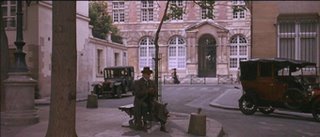The Bodies of Christ (Redux)


Hans Holbein the Younger (1497-1543), The Body of the Dead Christ in the Tomb, 1522 (above) and Andrea Mantegna (c. 1431-1506), Cristo in scruto, c. 1480 (below)
'In 1522 (the underlying coat bears the date 1521) Hans Holbein the Younger (1497-1543) painted a disturbing picture, the Body of the Dead Christ in the Tomb, which may be seen at the Basel Museum. The painting apparently made a tremendous impression on Dostoevsky. At the very outset of The Idiot, Prince Myshkin attempted to speak of it, but to no avail; only through a new polyphonic twist of the plot did he see a reproduction of it in Rogozhin's house and, "struck by a sudden thought", he exclaimed: "That picture . . . that picture! Why, some people may lose their faith by looking at that picture!" A little later, Ippolit, a peripheral character who nevertheless seems, in many respects, to be the narrator's and Myshkin's double, gave a striking account of it: "The picture depicted Christ, who has just been taken from the Cross. I believe that painters are usually in the habit of portraying Christ, whether in the Cross or taken down from the Cross, as still retaining a shade of extraordinary beauty on His face; that beauty they strive to preserve even in His moments of greatest agony. In Rogozhin's picture there was no trace of beauty. It was a faithful representation of the dead body of a man who had undergone unbearable torments before Crucifixion, been wounded, tortured, beaten by the guards, beaten by the people, when He carried the Cross and fell under its weight, and, at last, had suffered the agony of Crucifixion, lasting for six hours (according to my calculation, at least). It is true, it is the face of a man who had only just been taken from the Cross - that is, still retaining a great deal of warmth and life; rigor mortis had not yet set in, so that there is still a look of suffering on the face of the dead man, as though He were still feeling it (that has been well caught by the artist); on the other hand, His face has not been spared in the least; it is nature itself, and, indeed, any man's corpse would look like that after much suffering. I know that the Christian church laid it down in the first few centuries of its existence that Christ really did suffer and that the Passion was not symbolic. His body on the Cross was therefore fully and entirely subject to the laws of nature. In the picture the face is terribly smashed with blows, swollen, covered with terrible, swollen and bloodstained bruises, the eyes open and squinting; the large, open whites of the eyes have a sort of dead and glassy glint. But, strange to say, as one looks at the dead body of this tortured man, one cannot help asking oneself the peculiar, and interesting question: if such a corpse (and it must have been just like that) was seen by all His disciples, by His future chief apostles, by the women who followed Him and stood by the Cross, by all who believed in Him and worshipped Him, then how could they possibly believe, as they looked at the corpse, that that martyr would rise again? Here one cannot help being struck with the idea that if death is so horrible and if the laws of nature are so powerful, then how can they be overcome? How can they be overcome when even He did not conquer them, He who overcame nature during His lifetime and whom nature obeyed, who said Talitha cumi! and the damsel arose, who cried, Lazarus come forth! and the dead man came forth? Looking at that picture, you get the impression of nature as some enormous, implacable and dumb beast, or to put it more correctly, much more correctly, though it may seem strange, some huge engine of the latest design, which has endlessly seized, cut to pieces and swallowed up - impassively and unfeelingly - a great and priceless Being, a Being worth the whole of nature and all its laws, worth the entire earth, which was perhaps created solely for the coming of that Being! The picture seems to give expression to the idea of a dark, insolent and senselessly eternal power, to which everything is subordinated, and this idea is suggested to you unconsciously. The people surrounding the dead man, none of whom is shown in the picture, must have been overwhelmed by a feeling of terrible anguish and dismay on that evening which had shattered all their hopes and almost all their beliefs in one fell blow. They must have parted in a state of the most dreadful terror, though each of them carried away, within him a mighty thought which could never be wrested from him. And if, on the eve of the Crucifixion, the Master could have seen what He would look like when taken from the Cross, would He have mounted the Cross and died as He did? This question, too, you can't help asking yourself as you look at the picture.""
Holbein's painting represents a corpse stretched out by itself on a slab covered with a cloth that is hardly draped. Life-size, the painted corpse is seen from the side, its head slightly turned toward the viewer, the hair spread out on the sheet. The right arm is in full view, resting alongside the emaciated, tortured body, and the hand protrudes slightly from the slab. The rounded chest suggests a triangle within the very low, elongated rectangle of the recess that constitutes the painting's frame. the chest bears the bloody mark of a spear, and the hand shows the stigmata of the Crucifixion, which stiffen the outstretched middle finger. Imprints of nails mark Christ's feet. The martyr's face bears the expression of hopeless grief; the empty stare, the sharp-lined profile, the dull blue-green complexion are those of a man who is truly dead, of Christ taken by the Father ("My God, my God, why hast thou forsaken me?") and without the promise of Resurrection.
The unadorned representation of human death, the well-nigh anatomical stripping of the corpse conveys to viewers an unbearable anguish before the death of God, which here is mingled with our own death because there isn't the slightest suggestion of transcendency. What is more, Hans Holbein has given up all architectural or compositional fancy. The tombstone weighs down on the upper portion of the painting, which is merely twelve inches high, and intensifies the feeling of permanent death: this corpse will never rise again. The pall itself, reduced to a minimum of folds, emphasises, through that economy of motion, the feeling of stiffness and stony cold.
The viewer's gaze penetrates this closed-in coffin from below and, following the painting from left to right, stops at the stone set against the corpse's feet, sloping at a wide angle toward the spectators.
What was the purpose of a painting with such peculiar dimensions? Does the Dead Christ belong to the altar that Holbein did for Hans Oberried in 1520-21, in which the two outside wings depicted the Passion and the centre was saved for the Nativity and the Adoration? There is nothing to support such a hypothesis, which, however, is not implausible when one takes into account a few features it shares with the outside wings of the altar that was partially destroyed during iconoclastic outbursts in Basel.
Among the various interpretations given by critics, one stands out and seems today the most plausible. The painting was done for a predella that remained independent and was to be positioned above the visitors as they filed in, from the side and the left (for instance from the church's central nave toward the souther aisle). In the Upper Rhine region, there are churches that contain funerary recesses where sculpted Christly bodies are displayed. Might Holbein's work be a painterly transposition of such recumbent statues? According to one hypothesis, this Dead Christ was the covering for a sacred tomb open only on Good Friday and closed for the rest of the year. Finally, relying on X rays of the painting, Fridtjof Zschokke has shown that the Dead Christ was initially located in a semicircular recess, like the section of a tube. That location corresponds to the date inscribed next to the right foot and the signature: H. H. DXXI. One year later, Holbein substituted the arched recess with the rectangular one and signed above the feet: MDXXII H. H.
Italian iconography embellishes, or at least ennobles, Christ's face during the Passion; but above all, it surrounds Christ with figures that are plunged not only in grief but also in the certainty of the Resurrection, as if to suggest the attitude we too should adopt when facing the Passion. Holbein, on the contrary, leaves the corpse strangely alone. It is perhaps this isolation - an act of composition - that endows the painting with its major melancholy burden, more so than its delineation or colouring. To be sure, Christ's suffering is expressed through three components inherent in line and colour: the head bent backward, the contortion of the right hand bearing the stigmata, the position of the feet - the whole being bonded by means of a dark palette of greys, greens and browns. Nevertheless, such realism, harrowing on account of its very parsimony, is emphasised to the utmost through the painting's composition and location: a body stretched out alone, situated above the viewers and separated from them.
Cut off from us by its base but without any possibility for the gaze to extend to Heaven because the ceiling in the recess comes down low, Holbein's
Dead Christ is inaccessible, distant and without a beyond. It is a way of looking at mankind from afar, even in death. Just as Erasmus saw folly from a distance. It is a vision that opens out not onto glory but to endurance. Another, a new, morality resides in this painting.
Christ's dereliction is here at its worst: forsaken by the Father, He is apart from all of us. Unless Holbein, whose mind, pungent as it was, does appear to have led him across the threshold of atheism, wanted to include us personally, humans, aliens, spectators that we are, in this crucial moment of Christ's life. With no intermediary, suggestion or indoctrination, whether pictorial or theological, other than our ability to imagine death, we are led to collapse in the horror of the caesura that is death or to dream of an invisible beyond. Does Holbein forsake us, as Christ, for an instant, had imagine Himself forsaken? Or does he, on the contrary, invite us to change the Christly tomb into a living tomb, to participate in the painted death and thus and thus include it in our own life? In order to live with it and make it live, for if the living body in opposition to the rigid corpse is a dancing body, doesn't our life, through identification with death, become a "dance macabre", in keeping with Holbein's other well-known vision?
This enclosed recess, this well-isolated coffin simultaneously rejects us and invites us. Indeed, the corpse fills the entire field of the painting, without any laboured reference to the Passion. Our gaze follows the slightest physical detail: it is, as it were, nailed, crucified and riveted to the hand placed at the centre of the composition. Should we attempt to avert our gaze, it is quickly stopped, locked in on the distressed face or the feet propped against the black stone. And yet this walling-in allows for two prospects.
On the one hand, there is the insertion of the signature,
MDXXII H. H., at Christ's feet. Placing the painter's name, to which was often added that of the donor, in that position was common at the time. It is nevertheless possible that in abiding by that code Holbein inserted himself into the drama of the dead body. A sign of humility: the artist throwing himself at God's feet? Or a sign of equality? The painter's name is not lower than Christ's body - they are both at the same level, jammed into the recess, united in man's death, in death as the essential sign of mankind, of which the only surviving evidence is the ephemeral creation of a picture drawn here in 1521 and 1522!
We have, on the other hand, this hair and this hand that extend beyond the base as if they might slide over toward us, as if the frame could not hold back the corpse. The frame dates precisely from the end of the sixteenth century and includes a narrow edging, bearing the inscription
Jesus Nazarenus Rex Judaeorum, which encroaches on the painting. The edging, which seems nonetheless always to have been part of Holbein's painting, includes, between the words of the inscription, five angels bearing the instruments of the martyrdom: the shaft, the crown of thorns, the scourge, the flogging column, the cross. Integrated afterward in that symbolic framework, Holbein's painting recovers the evangelical meaning that it did not insistently contain in itself, and which probably legitimised it in the eyes of its purchasers.
Even if Holbein's painting had originally been conceived as a predella for an altarpiece, it remained alone; no other panel was added to it. Such isolation, as splendid as it is gloomy, avoided Christian symbolism as much as the surfeit of German Gothic style, which combined painting and sculpture but also added wings to altarpieces, aiming for syncretism and the imparting of motion to figures. In the face of that tradition, which directly preceded him, Holbein isolated, pruned, condensed and reduced.
Holbein's originality, then, lies in this vision of Christly death that is devoid of pathos and is intimate on account of its very banality. Humanisation thus reached its highest point: the point at which glory is obliterated though the image. When the dismal brushes against the nondescript, the most disturbing sign is the most ordinary one. In contrast to Gothic enthusiasm, humanism and parsimony were the inverted products of melancholia.
. . .
Finally, Mantegna's famous
Cristo in scruto (c. 1480, at the Brera Museum in Milan) may be considered the precursor of the quasi-anatomical vision of the dead Christ. With the soles of the feet turned toward the viewers and the foreshortened perspective, Mantegna's corpse imposes itself with a brutality that verges on the obscene. Nevertheless, the two women who appear in the upper left hand corner of this painting introduce the grief and the compassion that Holbein puts aside precisely by banishing them from sight or else creating them with no mediator other than the invisible appeal to our all-too-human identification with the dead Son . . . And yet, always heedful of the Gothic spirit, Holbein maintains grief while humanising it, without following the Italian path of negating pain and glorifying the arrogance of the flesh or the beauty of the beyond. Holbein is in another dimension: he makes commonplace the Passion of the Crucified Christ in order to make it more accessible to us. Such a humanising gesture, which is not without a modicum of
irony toward transcendence, suggests a tremendous amount of mercy with respect to
our death.'
From
Holbein's Dead Christ by
Julia KristevaMusique Du Jour: 'Erbarme Dich' (from the St. Matthew Passion, BWV 244), J. S. Bach



























,%2BSummer%2BInterior,%2B1909.jpg)
,%2BEleven%2BA.M.,%2B1926.jpg)
,%2BAutomat,%2B1927.jpg)
,%2BHotel%2BRoom,%2B1931.jpg)
,%2BRoom%2Bin%2BNew%2BYork,%2B1932.jpg)
,%2BMorning%2BSun,%2B1952.jpg)





















